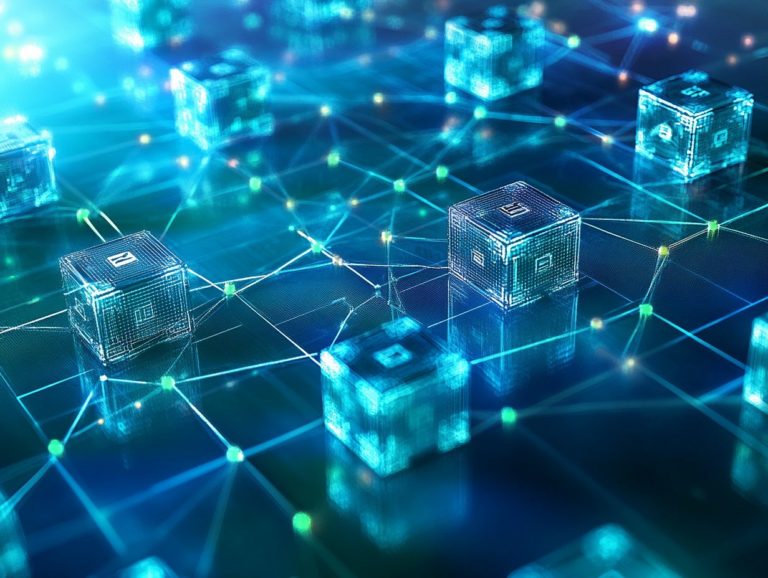What is 5G Technology? An Overview
In recent years, 5G technology has emerged as a transformative force in telecommunications, offering faster speeds, greater capacity, and lower latency than anything we’ve seen before.
But what is 5G, and how did we arrive at this milestone? This article takes you on a journey through the evolution of mobile networks from 1G to 5G. We will illuminate key features and potential applications that promise to revolutionize industries and enhance everyday life.
It also delves into pressing concerns and controversies surrounding this groundbreaking technology. Immerse yourself in the discussion to grasp how 5G could shape your future!
Contents
Key Takeaways:

- 5G technology is the next generation of wireless networks, promising faster speeds, higher capacity, and lower latency.
- Since its development in the late 2000s, 5G has evolved from earlier generations of wireless technology, each bringing significant improvements.
- With potential applications in healthcare and transportation, 5G could greatly impact our daily lives and shape the future of technology.
Understanding 5G Technology
Understanding 5G technology is crucial in today’s fast-paced digital world. It represents a major advancement in wireless communication, offering faster internet access with impressive download and upload speeds.
This next-generation mobile network is designed to deliver ultra-reliable, low-delay connections, revolutionizing industries like smart manufacturing, virtual reality, and self-driving vehicles.
It also paves the way for innovations in artificial intelligence and the Internet of Things (IoT). With its ability to enhance healthcare technology and contribute to smart city growth, 5G carries significant economic potential for telecommunications companies and the global GDP.
What is 5G?
5G is the fifth generation of wireless technology, designed to elevate mobile networks by delivering faster data rates, reduced delays, and enhanced connectivity. This advanced technology operates across a spectrum of lower, mid, and high-frequency bands, supporting more devices simultaneously.
One impressive aspect of 5G is its capacity to achieve data speeds up to 100 times faster than its predecessor, 4G. This means you can enjoy seamless HD streaming, instant downloads, and an enriched user experience.
With delays cut to as low as one millisecond, 5G dramatically improves real-time communication, which is vital for applications requiring instant responses, like self-driving cars and augmented reality.
Additionally, 5G enhances mobile experiences and supports innovations such as IoT and edge computing, allowing for smarter cities, industrial automation, and remote healthcare. This fundamentally transforms how society engages with technology daily.
History and Development of 5G
The evolution of 5G technology is a remarkable journey, starting with 1G and advancing through 2G, 3G, and 4G. Each generation has brought substantial improvements in telecommunications capabilities, setting the stage for the transformative power of 5G.
As you explore this progression, you can appreciate how these advancements have shaped the landscape of connectivity and communication.
Don’t miss out on the incredible potential of 5G! Stay informed about its developments and explore related topics to understand how it may impact your life.
Evolution from 1G to 5G

The evolution from 1G to 5G is a remarkable journey through telecommunications technology. It has transformed basic voice communication into the high-speed, data-driven capabilities we experience today.
This journey begins with the first generation, or 1G, allowing users to make analog voice calls. Although clarity and security were limited, it revolutionized communication.
With the advancement to 2G, users gained access to text messaging and digital services. However, data restrictions still loomed large.
The leap to 3G was a game changer, introducing mobile internet that enabled web browsing and access to multimedia content. This set the stage for the app revolution.
4G brought skyrocketing data transmission speeds, paving the way for video streaming and online gaming as everyday activities.
Each generation has laid the foundation for the robust features and lightning-fast applications of 5G, such as real-time gaming and smart city technologies. This evolution illustrates a monumental leap in capabilities and user experience, making each step an exciting milestone in our telecommunications journey.
Key Features of 5G Technology
Get ready for 5G! Its amazing features will blow your mind, including incredibly fast speed, increased connection capacity, and impressively low latency.
These attributes transform mobile networks and elevate data rates across various applications, setting a new standard in connectivity.
Speed, Capacity, and Latency
The speed of 5G technology can soar up to 10 Gbps, leaving previous generations behind. Its enhanced capacity allows millions of devices to connect simultaneously, all while keeping latency to an absolute minimum.
This leap from 4G, which typically maxes out around 100 Mbps, highlights a transformative shift essential for modern applications. Beyond just speed, 5G reduces latency the delay before data transfer begins to as low as 1 millisecond, a far cry from the 30-50 milliseconds seen in 4G networks. This is crucial for real-time communications, especially in scenarios like autonomous driving.
The implications for smart factories are significant. With strong connectivity, devices can function in a coordinated and efficient manner, reducing downtime and boosting productivity.
As smart cities evolve, this interconnectedness will enable everything from traffic management to energy distribution. 5G technology has the potential to reshape our future.
Potential Applications of 5G
The potential applications of 5G technology are vast and transformative. They are poised to impact various sectors such as healthcare, smart cities, virtual reality, and autonomous vehicles.
This evolution drives new innovations and efficiencies that could redefine experiences and operations in these fields.
Impact on Industries and Daily Life

5G will revolutionize your daily life and industries, making them smarter and more efficient than ever! This technology ushers in the era of smart cities, enhanced healthcare services, and a connected Internet of Things (IoT).
As 5G weaves itself into various sectors, it serves as a catalyst for innovative solutions to pressing challenges. In healthcare, 5G enables real-time patient monitoring systems, allowing healthcare providers to offer timely remote consultations especially crucial during health crises.
Case studies of 5G in telemedicine programs reveal quicker response times and improved patient outcomes.
In urban development, cities like Barcelona harness 5G to implement smart lighting and traffic systems, optimizing energy consumption and alleviating congestion.
Through these advancements, 5G not only elevates quality of life but also drives economic growth and sustainability.
Concerns and Controversies Surrounding 5G
Despite its impressive advancements, 5G technology has ignited concerns and controversies surrounding health and safety, privacy, and security issues. These topics have emerged in public discourse.
Stay informed about 5G. Your understanding is key to navigating the future!
Health and Safety Concerns
Health and safety concerns surrounding 5G technology focus primarily on the effects of the radio waves emitted by this new network.
As this cutting-edge technology rolls out globally, you may ponder its long-term implications. Some scientific studies suggest that 5G radio waves could be linked to health risks, such as increased cancer risk and neurological issues.
Conversely, other research indicates that 5G exposure remains within safety limits set by regulatory bodies, suggesting minimal risk to human health.
Experts urge continued research to clarify these concerns, as public opinion often swings between fear and excitement regarding technological advancements.
Privacy and Security Issues
The rollout of 5G technology raises significant privacy and security concerns, especially about data protection and the responsibilities of telecommunications providers.
As this advanced network infrastructure becomes more common, the implications for your connected devices and the vast amounts of data they generate are profound.
This landscape can create vulnerabilities that malicious actors might exploit, including unauthorized access and data breaches.
Regulatory challenges arise as policymakers work to establish strong guidelines that protect your privacy without stifling innovation. Telecommunications companies are enhancing their cybersecurity measures and collaborating with regulators to develop frameworks that safeguard your data in the 5G landscape.
Frequently Asked Questions

What is 5G Technology? An Overview
5G technology is the latest generation of wireless networks designed to provide faster and more reliable connectivity. It upgrades the previous 4G technology and promises to revolutionize how we use and experience wireless networks.
What are the key features of 5G technology?
Key features of 5G technology include higher data transfer speeds, lower latency (the delay in data transfer), increased network capacity, and support for more connected devices. It also offers improved network efficiency and better coverage compared to older wireless technologies.
How does 5G technology differ from 4G technology?
5G technology significantly differs from 4G in various ways. It offers much faster data speeds, with potential peaks reaching up to 20 Gbps. Additionally, it has lower latency, allowing for quicker data transfer. 5G uses a higher frequency spectrum, enabling more data transmission at once and supporting a larger number of connected devices.
What are the potential applications of 5G technology?
5G technology can impact various industries, including healthcare, transportation, manufacturing, and entertainment. It enables advancements like remote surgeries, self-driving cars, and smart factories. Furthermore, it enhances virtual and augmented reality experiences and supports Internet of Things (IoT) devices.
Are there any potential drawbacks or concerns with 5G technology?
As with any new technology, concerns and potential drawbacks exist. Some worry about health effects from exposure to higher frequency radiation. Additionally, there are concerns regarding the cost and accessibility of 5G networks, as well as potential increases in cyber threats and privacy issues.
When will 5G technology be widely available?
5G technology is currently rolling out in many parts of the world, but it may take time before it is widely accessible. It is expected to become more common and widely adopted in the coming years as network infrastructure and devices continue to be updated to support it.






